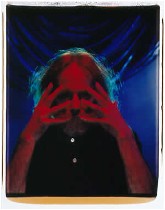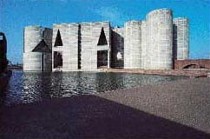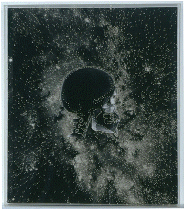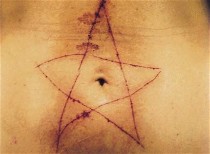 Our big day in the Big Apple, besides Currin and Harlem and Gorky, also included Lucas Samaras and Lucas Samaras and Lucas Samaras (shown, one of his dye diffusion prints–a self-portrait of course–in the Whitney collection) at the Whitney.
Our big day in the Big Apple, besides Currin and Harlem and Gorky, also included Lucas Samaras and Lucas Samaras and Lucas Samaras (shown, one of his dye diffusion prints–a self-portrait of course–in the Whitney collection) at the Whitney.
This Roberta said she found depressing.
Not me, except for the flashing thought that this show reflected the entirety of his life. Is it enough to expend most of your life force in making so many self-portraits that they fill a floor of the Whitney?
 (This thought was reinforced yesterday when I saw “My Architect,” the Louis Kahn documentary by his son Nathaniel. I came away filled with sadness for a charismatic man who did brilliant work (shown, his government building in Bangladesh) and served as an architectural guru for those who followed him, but was not quite a whole human being.)
(This thought was reinforced yesterday when I saw “My Architect,” the Louis Kahn documentary by his son Nathaniel. I came away filled with sadness for a charismatic man who did brilliant work (shown, his government building in Bangladesh) and served as an architectural guru for those who followed him, but was not quite a whole human being.)
Not only does Samaras’ legendary self-absorption appear to be limitless (the show is appropriately named Unrepentant Ego: The Self-Portraits of Lucas Samaras), but so were his means of expressing it.
 Amongst Samaras’ strengths are that his psychedelic pieces don’t look dated; that his self-portraits in old age are as beautiful as his youthful ones; that his materials and methods merge insider and outsider art; that he did groundbreaking work in the use of manipulation of Polaroids; and that he extended self-exploitation as an art form to new heights and lengths.
Amongst Samaras’ strengths are that his psychedelic pieces don’t look dated; that his self-portraits in old age are as beautiful as his youthful ones; that his materials and methods merge insider and outsider art; that he did groundbreaking work in the use of manipulation of Polaroids; and that he extended self-exploitation as an art form to new heights and lengths.
 Besides the famous, distorted polaroids, I was wowed by the intense pastels and the fine draftsmanship of the drawings.
Besides the famous, distorted polaroids, I was wowed by the intense pastels and the fine draftsmanship of the drawings.
The boxes, mirroring his own not-so-sweet self, were, as usual, a mix of over-the-top decoration with creepy materials suggesting pain and danger.
 The performance/body art/danger bring to mind the dreaded Marina Abramovic and her self-flagellation (shown, her belly cut with razor), work I detest, but somehow in Samaras’ work, the pain and danger remain metaphorical and metaphysical, not physical. This goes to prove the guy isn’t so crazy after all.
The performance/body art/danger bring to mind the dreaded Marina Abramovic and her self-flagellation (shown, her belly cut with razor), work I detest, but somehow in Samaras’ work, the pain and danger remain metaphorical and metaphysical, not physical. This goes to prove the guy isn’t so crazy after all.
My main complaint was that a whole floor of LS is half-a-floor too much.
 By the way, this was the Whitney’s second major Samaras show. The first was 30 years ago, and the Whitney is the largest repository of Samaras’ work in a public institution, according to Whitney Director Maxwell L. Anderson.
By the way, this was the Whitney’s second major Samaras show. The first was 30 years ago, and the Whitney is the largest repository of Samaras’ work in a public institution, according to Whitney Director Maxwell L. Anderson.









